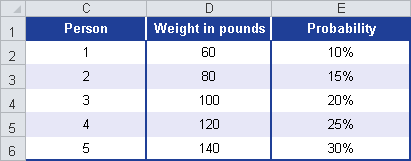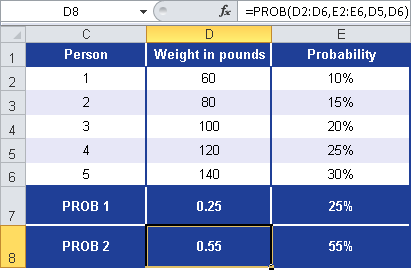Syntax. PROB(x_range,prob_range,lower_limit,upper_limit)
Definition. This function returns the probability for an interval between two values. If upper_limit is not specified, the function calculates the probability that the values in x_range are equal to lower_limit.
Arguments
x_range (required). The range of random variable realizations that have associated probabilities
prob_range (required). A set of probabilities associated with values in x_range
lower_limit (required). The lower limit of the values for which the probability is calculated
upper_limit (optional). The upper limit of the values for which the probability is calculated
Note
If any value in prob_range is less than or equal to 0 or greater than 1, the function returns the #NUM! error.
If the sum of the values in prob_range is greater than 1, PROB() returns the #NUM! error.
If upper_limit is not specified, PROB() returns the probability for lower_limit.
If x_range and prob_range contain a different number of data points, PROB() returns the #N/A error.
Background. The PROB() function calculates the probability of a value interval where the single probabilities are known. In other words, the function adds up the probabilities of the values within this interval. The values correspond to the x_range argument (the values to be examined), and the probabilities correspond to the prob_range argument (the probabilities associated with the values). All probabilities have to be greater than or equal to 0 (0 percent) and less than or equal to 1 (100 percent), and the sum has to be 1.
Example. You are a doctor and offer a free health check for your patients that includes weighing. Five of your patients have been weighed. Based on previous weighings, you were able to associate probabilities with the current values. You entered the values and their probabilities into a table (see Figure 12-117).
As Patient 6 enters the examination room you ask yourself the following questions:
How high is the probability that the weight of Patient 6 matches value 4 and the patient weighs 120 pounds?
How high is the probability that the weight of Patient 6 is between values 4 and 5 and the patient weighs between 120 and 140 pounds?
The PROB() function answers these questions (see Figure 12-118).
The answers to these questions are:
The probability that Patient 6 will weigh 120 pounds is 25 percent.
The probability that Patient 6 will weigh between 120 and 140 pounds is 55 percent.
As you can see in Figure 12-118, the optional upper_limit argument wasn’t specified to answer question 1. This means that the PROB() function calculated the probability for lower_limit (in this example, 120 pounds).
To get an answer to question 2, both arguments (lower_limit and upper_limit) had to be specified. This means that the PROB() function calculated the probability for value x within an interval (in this example, 120 to 140 pounds).


